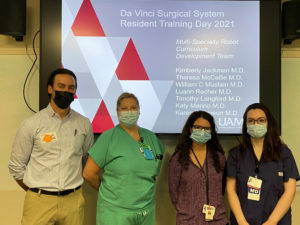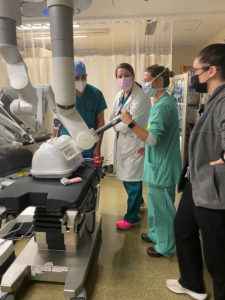By Linda Satter
A new multispecialty robotic surgery curriculum for residents has started up at the University of Arkansas for Medical Sciences (UAMS).

Not only does it provide surgical residents with expertise in the latest surgical technology, it uniquely allows three surgical specialties to learn from and with each other: general surgery, obstetrical/gynecologic (OBGYN) surgery and urologic surgery.
To kick off the curriculum that was jointly designed by robotic-trained surgeons in all three disciplines alongside a surgical education and simulation expert, all 45 available surgical residents gathered in two-hour shifts on Sept. 1 and 2 in the UAMS Centers for Simulation Education for an introductory session with the da Vinci Surgical System. The sessions were taught by W. Conan Mustain, M.D., (colorectal surgery); Luann Racher, M.D., (OBGYN); Kim Jackman, M.D., (general surgery); Theresa McCallie, M.D., (general surgery); Timothy Langford, M.D., (urology); Katy Marino, M.D., (thoracic surgery); and Karen J. Dickinson, M.D., (general surgery).
While the laboratory has its own robotic simulation equipment, extra equipment provided for those two days by Intuitive Corp., which manufactures the da Vinci system, made it possible to introduce the curriculum to the largest number of residents in one learning event, said Dickinson, an assistant professor of surgery and director of Interprofessional Education for Simulation and Clinical Skills Training.
The curriculum is being initiated in the 2021-22 academic year for all surgical residents at UAMS. This includes 30 general surgery residents, 10 urology residents and 19 OB/GYN residents.

Laparoscopic surgery is performed through small incisions as the surgeon holds the tools in hand and watches a live, high-definition video feed from a tiny camera inserted within the patient. Robotic-assisted surgery is also performed through small incisions but, in contrast, the surgeon is seated at a console and, while watching on a magnified, high-definition screen that shows a 3D view of the inside of the body, uses hand controls to manipulate the robotic arms and the tiny instruments they hold.
“Robotic-assisted surgery provides several advantages over conventional laparoscopy,” said Mustain, an assistant professor of surgery in the College of Medicine. “The surgeon console provides 3D visualization through use of a binocular camera, which the surgeon controls without relying on an assistant. The robotic instruments provide tremor-filtered, wristed movements that mimic the human hand, unlike the limited range of conventional laparoscopic instruments. The combination of more control and precision enables complex tasks to be completed in tight spaces.”
“As a good surgeon, you need to have multiple techniques in your skill set. You need to be able to say to your patients I am offering you the right approach for your disease and for you as my patient,” Dickinson said. “This is where a robust surgical education is essential, which is what we are offering to all surgical residents here at UAMS.”
As part of the robotic simulation training, faculty from the three surgical specialties in the curriculum worked together to help the residents try out various tasks using the robotic arms, such as picking up a peg and transferring it to another location, or tying and untying a string without breaking it.
“The robot simulation day was a great opportunity for hands-on experience with both bedside assistance and using the console. I particularly enjoyed learning from multidisciplinary faculty,” said Jennifer Greulich, M.D., an OBGYN resident.
Dickinson said the benefit of robotic simulator training is to augment the operating room (OR) experience. Surgical faculty members will be able to log on and review each student’s simulation experiences and offer them specific guidance to prepare for and build on their OR training. She said an advantage of combining the specialties by a common curriculum is that residents are also able to learn from each other and from multispecialty faculty to develop their robotic surgical skills.
